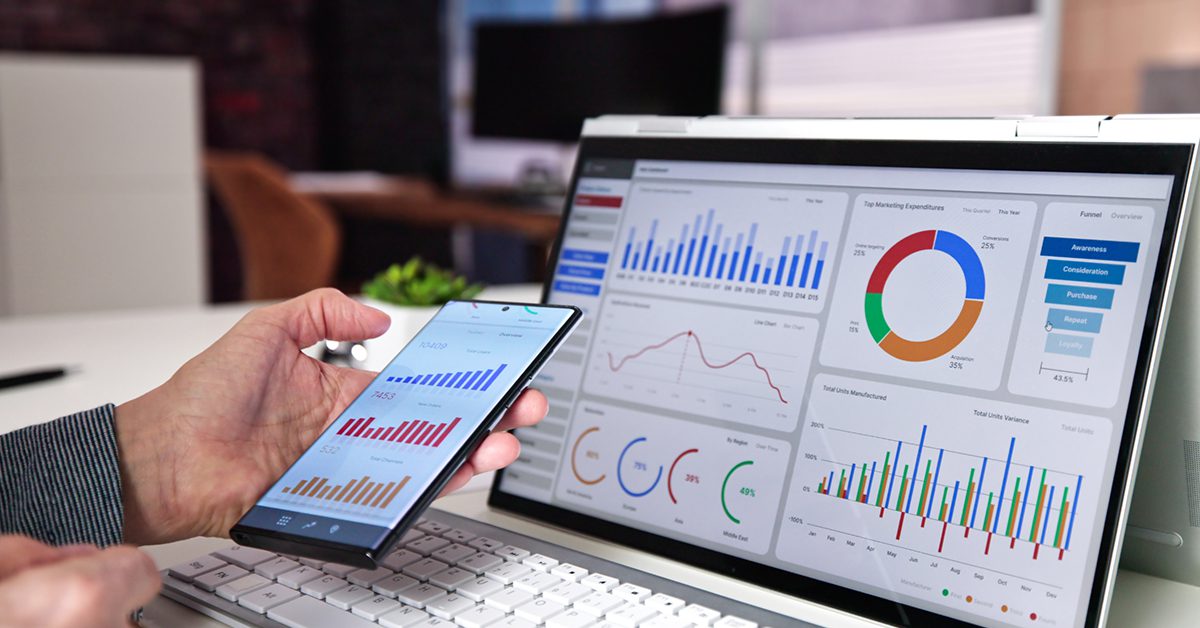When it comes to tracking your website’s performance, it’s all about the data. With so many metrics and numbers floating around, it can be a big job. But focusing on the right key performance indicators (KPIs) can make a huge difference in determining where to focus your marketing efforts and what changes you need to make to see improvements.
How many visitors are coming to your site, and where are they coming from? How much time are your website visitors spending on each web page, and what actions are they taking?
Here are the top website KPIs to help you measure success:
- Traffic Sources
- Unique Visitors
- Average Session Duration
- Page Visits Per Session
- Bounce Rate
- Conversion Rate
- Page Load Time
- Goal Completions
What is a Website KPI and Why is it Important?
A website KPI (Key Performance Indicator) is a measurable value that shows how effectively your website is meeting specific objectives, like attracting your target audience or converting them into customers.
Regularly tracking website KPIs gives you a clear picture of what’s working and where you might need to make changes in your SEO strategy or marketing campaigns to improve results. These metrics keep you on track with your goals, helping you make data-driven decisions to enhance your website’s performance.
What Website KPIs Should You Be Tracking?
There are endless metrics you could be tracking for your website, but focusing on the ones that truly impact your business goals is what makes the difference. The following key website KPIs reveal how well your site is performing, where your visitors are coming from, and how engaged they are with your content.
1. Traffic Sources
Traffic sources tell you where your visitors are coming from (organic search, direct visits, social media, referral links, paid ads, etc). Knowing where your visitors come from helps you understand which channels are driving the most traffic to your site. This insight is important for allocating resources across your marketing campaigns and building on the channels that work best for you.
Ideally, you should aim for a balanced mix of website traffic so you’re not overly reliant on one channel. Many websites strive for at least 50% of traffic from organic sources.
Tips for Improvement:
- Focus on organic SEO services to increase traffic.
- Run targeted social media ads and engage with followers.
- Strengthen partnerships for more referral traffic.
2. Unique Site Visitors
This metric counts the number of individual visitors to your website over a specific period. Unique website visitors help you gauge how many new people are coming to your site, which is essential for building awareness and expanding your reach.
The goal or average for site visitors varies widely by industry, but an increase in unique visitors month-over-month is usually a good sign.
Tips for Improvement
- Publish valuable, shareable content regularly.
- Utilize link-building services from a marketing professional to expand your reach.
- Leverage social media and online communities to drive traffic.
3. Average Session Duration
The average session duration measures the average time visitors spend on your site during a single session. A longer session duration usually indicates higher engagement, meaning visitors find your content valuable and worth exploring.
The average session duration is generally around 2-3 minutes, but the higher, the better.
Tips for Improvement
- Add engaging multimedia content, like videos or infographics.
- Improve internal linking to encourage deeper site exploration.
- Ensure content is relevant, valuable, and easy to read.
4. Page Visits Per Session
Pages per session tracks how many web pages the same visitor clicks to during a single session. A higher number of page visits per session suggests that visitors are interested in exploring more of your content, which often leads to higher engagement and conversion rates.
Aim for around 2-3 pages per session, though this can also vary by industry.
Tips for Improvement
- Use strong internal links to encourage further browsing.
- Create a logical flow of content with clear pathways between pages.
- Offer related content recommendations or product suggestions.
5. Bounce Rate
Bounce rate measures the percentage of visitors who leave your site after viewing only one particular page. A high bounce rate can indicate that visitors aren’t finding what they need, or that your site’s content or layout needs improvement.
A bounce rate of 40-60% is typical for most sites, though lower is generally better.
Tips for Improvement
- Optimize page load speeds to retain visitors.
- Make sure your content aligns with user intent and is easy to digest.
- Use engaging CTAs to guide users to other pages.
6. Conversion Rate
Conversion rate measures the percentage of visitors who complete a desired action, like signing up for a newsletter or making a purchase. Your conversion rate is one of the most important key metrics you should be tracking and is a direct indicator of how well your site is achieving its business goals.
Average conversion rates are typically between 2-5%, but this can vary significantly by industry.
Tips for Improvement
- Simplify the checkout process and reduce form fields.
- Use clear, persuasive CTAs and highlight benefits.
- Optimize landing pages for relevance and user intent.
7. Page Load Time
This KPI measures the time it takes for a page on your site to load completely. Faster load times lead to a better user experience, higher engagement, and better search rankings. Pages that load quickly also reduce bounce rates, as users are more likely to stay and explore your content when they don’t have to wait for it to appear.
Aim for page load times of under 4 seconds, as anything longer can lead to higher bounce rates.
Tips for Improvement
- Compress images to reduce load times.
- Limit the use of plugins and heavy scripts.
- Implement a content delivery network (CDN).
8. Goal Completions
Goal completions track the total number of specific actions completed by visitors, like form submissions on a landing page, downloads, or purchases. This KPI lets you measure progress on important objectives, showing whether your site is effectively driving desired outcomes.
The average measure of success here is going to depend significantly on your goals, but a steady increase in goal completion over time is a good indicator of website success.
Tips for Improvement
- Make CTAs prominent and clearly actionable.
- Ensure forms are short and easy to complete.
- Streamline the user journey to the desired goal (e.g., sign-up or checkout).
Tools For Tracking Website KPIs

Tracking your website KPIs is much easier with the right web analytics tools. There are many on the market, each offering a unique perspective on site performance, user behavior, and web traffic. Tools like Google Analytics give you a deep dive into essential metrics, including traffic sources, bounce rate, average time on page, and conversion rates. This level of insight helps you understand how users are finding your site, which pages keep them engaged, and where improvements might be needed.
For SEO-specific metrics, tools like SEMrush and Ahrefs are fantastic for tracking your website’s visibility on search engines. These tools allow you to analyze keyword performance, backlinks, and competitive positioning. They also provide insights into site speed and other technical aspects of site performance that impact SEO.
How Your Website KPIs Should Drive Your Marketing Strategy
Your website KPIs aren’t just numbers—they’re valuable insights that can you create a smarter, more effective marketing strategy. By regularly monitoring and interpreting your KPIs, you can understand what’s working, what needs improvement, and where to focus your marketing efforts for maximum impact.
For example, if your traffic sources KPI shows that most of your visitors are coming from social media but few are converting, it might be time to focus on refining your social media messaging or targeting a different audience segment.
On the other hand, if your conversion rate is high but unique visitors are low, your strategy should shift toward driving more traffic, perhaps through SEO or paid ads, to bring new eyes to your already high-performing site.
KPIs like bounce rate and page load time offer insight into the user experience, helping you spot any friction points that may need optimizing. If bounce rates are high, focus on creating more engaging landing pages, simplifying navigation, and ensuring the content aligns with visitor intent.
For goal completions—a strong indicator of success—look at which pages lead users to complete those goals. You can then use this knowledge to guide users more effectively toward similar actions on other pages or through targeted ad campaigns.
What Are Your Key Performance Indicators Telling You?
Your website’s KPIs can provide powerful insights into what’s working and where there’s room for improvement. By regularly monitoring these metrics, you can make informed adjustments that enhance your website’s performance, increase engagement, and drive more conversions. Keeping an eye on your KPIs helps you stay aligned with your business goals and ensures that your website is doing everything it can to support your growth.







